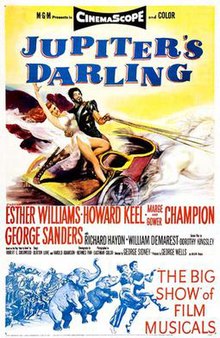Jupiter's Darling
| Jupiter's Darling | |
|---|---|
 Film poster | |
| Directed by | George Sidney |
| Written by | Dorothy Kingsley |
| Produced by | George Wells |
| Starring | Esther Williams Howard Keel Marge Champion Gower Champion George Sanders Richard Haydn |
| Cinematography | Charles Rosher Paul Vogel |
| Edited by | Ralph E. Winters |
| Music by | David Rose |
| Distributed by | Metro-Goldwyn-Mayer |
Release date |
|
Running time | 95 minutes |
| Country | United States |
| Language | English |
| Budget | $3,337,000[1] |
| Box office | $2,520,000[1] |
Jupiter's Darling is a musical romance film released by MGM in 1955 and directed by George Sidney. It starred Esther Williams as the Roman woman Amytis, Howard Keel as Hannibal, the Carthaginian military commander and George Sanders as Fabius Maximus, Amytis's fiance. In the film, Amytis helps Hannibal swim the Tiber River to take a closer look at Rome's fortifications.
The film features many historical characters, including Roman generals Fabius Maximus and Scipio Africanus who appears briefly, in addition to Hannibal. Carthaginians Mago Barca and Maharbal also appear.
Jupiter's Darling was based on Robert E. Sherwood's anti-war comedy play The Road to Rome (1927).[2]
The film was the last of three films Williams and Keel made together, the other two being Pagan Love Song (1950) and Texas Carnival (1951).
Cast
- Esther Williams as Amytis
- Howard Keel as Hannibal
- Marge Champion as Meta
- Gower Champion as Varius
- George Sanders as Fabius Maximus
- Richard Haydn as Horatio
- William Demarest as Mago
- Norma Varden as Fabia
- Douglass Dumbrille as Scipio
- Henry Corden as Carthalo
- Michael Ansara as Maharbal
- Martha Wentworth as Widow Titus
- John Olszewski as Principal Swimming Statue
- Esther Williams' singing voice dubbed by Jo Ann Greer
Production
Williams had been on maternity leave for three months while pregnant with daughter Susan, and had assumed that she would get straight to work on the film Athena. She, along with writers Leo Pogostin and Chuck Walters created the premise for Athena while making Easy to Love, and Walters finished the script while Williams was on maternity leave. However, Athena had already begun shooting when Williams arrived back from leave, and the studio had changed the swimming sequences to dancing sequences and replaced Williams with Jane Powell. Williams was then assigned Jupiter's Darling.[3] Jo Ann Greer, who sang for Williams, also dubbed June Allyson in MGM's The Opposite Sex and Rita Hayworth in three films, including Pal Joey.
During shooting, Williams broke her left eardrum, which had already been broken in five other films. She was fitted with a prosthesis from latex that covered her nose and ears that prevented water from rushing in. As a result, she could barely hear, taste or smell while wearing it.[4]
In one of the film's scenes, Amytis, while fleeing from Hannibal and his soldiers, rides a horse over the edges of a cliff on the Tiber River. Williams refused to do the scene, and when the studio refused to cut it, the director called in a platform diver that Williams knew, Al Lewin. The stunt took place one time; the studio got its shot, and Lewin broke his back.[5]
Release
The film's world premiere was held in Milwaukee, Wisconsin.[6] The cast, including a 350-pound baby elephant named Jupiter's Darling, embarked on a tour of nine U.S. cities.[7]
Box office reception was poor - according to MGM records it made $1,493,000 in the US and Canada and $1,027,000 elsewhere resutling in a loss of $2,232,000.[1][8]
Critical reception
A 1955 New York Times review of the film claimed that "Esther Williams must be getting bored with water. She goes swimming only three times in M-G-M's "Jupiter's Darling," which came yesterday to the Music Hall, and two of these times are forced upon her. She dunks only once for fun. And that, we might note, is the most attractive and buoyant thing in the film. It comes when Miss Williams, cast rashly as the fiancée of Emperor Fabius Maximus of Rome, peels off her stola and tunic after a long hot day in town and goes swimming in the pool of her villa, which is fancier than any pool in Hollywood." It also stated that "Miss Williams had better get back in that water and start blowing bubbles again."[2]
Notes
- ^ a b c The Eddie Mannix Ledger, Los Angeles: Margaret Herrick Library, Center for Motion Picture Study.
- ^ a b New York Times review
- ^ Williams, pp. 257.
- ^ Williams, p. 260.
- ^ Williams, p. 261.
- ^ TCM listing for Jupiter's Darling
- ^ Williams, p. 160.
- ^ Scott Eyman, Lion of Hollywood: The Life and Legend of Louis B. Mayer, Robson, 2005 p 464
See also
References
- Williams, Esther (1999). The Million Dollar Mermaid: An Autobiography (1st ed.). ISBN 978-0-15-601135-8. ISBN 0-15-601135-2. Retrieved 2009-12-11.
Further reading
- Monder, Eric (1994). George Sidney:a Bio-Bibliography. Greenwood Press. ISBN 978-0-313-28457-1.
External links
- 1955 films
- 1950s musical comedy films
- American musical comedy films
- American romantic comedy films
- American films
- American romantic fantasy films
- American romantic musical films
- Second Punic War films
- Films based on plays
- Films set in ancient Rome
- Films directed by George Sidney
- Metro-Goldwyn-Mayer films
- Musical fantasy films
- Swimming films
- Hannibal
